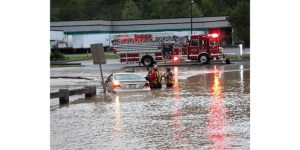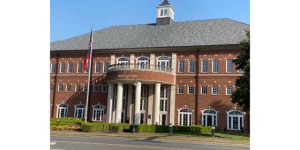Civil War anniversary: Origins of the Catholic Church in Dalton
Published 10:52 pm Saturday, March 28, 2015
In 1820 the Vatican created a diocese in Charleston, S.C., that covered North and South Carolina, Georgia and part of Florida. The church hoped that introducing episcopal authority into the region might stabilize Catholicism and encourage its growth. The man chosen to lead the new diocese was John England, a 34-year-old Irishman.
Bishop England served the diocese for more than 20 years and during his administration, (1820-1842), he laid the groundwork for many important Catholic institutions in the state.
Trending
Catholic communities spread across Georgia to include Columbus, Athens and Atlanta and in all probability missionary priests were ministering to Atlanta by the early 1840s. The Catholics living in Atlanta completed their first church building in 1848. It was a simple wood frame structure similar in construction to the surrounding buildings and was the first Catholic Church built in North Georgia. Father John Barry was the missionary priest assigned to Atlanta during the years of the church construction.
The Catholic Church follows the railroad and comes to Dalton
The Western and Atlantic Railroad was completed from the Chattahoochee River to Dalton and on June 22, 1847, the first train rolled into town. A big day of celebration ensued with a crowd of no less than 5,000 present. Many of the railroad workmen were Catholic Irish emigrants looking for the American dream. The early Catholic missionary priests followed the railroad from camp to camp and town to town seeking out Catholics to provide them with the sacraments and consolations of the church. In 1850 the number of Catholics in Georgia had grown to more than 5,000 and a new diocese of Savannah was formed, taking in the entire state. Spiritual direction of Catholics in Georgia passed from the Diocese of Charleston to the Diocese of Savannah and Frances X. Gartland (1808-1854) was the first bishop to serve in Savannah. In 1851, Father Jeremiah F. O’Neill Jr. (1826-1868) became the first priest to be officially assigned to Atlanta.His ministry fanned out to places like Newnan, Carrollton, the Iron Works in Cartersville and Dalton.
A 1854 publication states that “two fine lots were presented by the Dalton City Company for the erection of a Catholic Church in Dalton and the Reverend J. F. O’Neill Jr. of Atlanta visits there monthly.” It was probably during this time, 1854-1859, when the Catholic Church in Dalton was built and referred to ”as a small elegant church” and probably much like the one in Atlanta.
Mr. John W. Walker of Dalton, a carpenter who did a portion of the work during its construction, said,” it was quite a neat and comfortable church, well finished, sufficiently commodious and suited in construction for the purpose intended and worth $5,000.”
Trending
On Sept. 20, 1854, Gartland died of yellow fever and his successor, Father John Barry of Atlanta was consecrated in August of 1857. It was Barry, the second bishop of the Diocese of Savannah, who accepted the deeds for the Dalton church property and remained bishop during the time of the church’s construction. On July 8, 1859, Barry was in Dalton and purchased an additional lot, No. 5, from the Dalton City Company for $100. This lot joined lots Nos. 1 and 3 that were given previously and resulted in street frontage of 150 feet on Spring Square, now Pentz Street, and running back 132 feet along West Morris Street to the fence of S.S. Turner. It is today the property of Fashion Cleaners.
Barry died later that year on Nov. 21, 1859. His successor was Bishop Augustine M. Verot. Other priests were known to be visiting Dalton that year. Father Patrick J. Kerby performed the wedding of Martin Dooly and Meita M. Lauracy on Feb. 22, 1859.
War and hospitals come to Dalton
Things were changing in Georgia and war clouds loomed on the horizon. From June 1862 through October of 1863, in the midst of the Civil War, the Baptist, Methodist and the Presbyterian churches of Dalton at various times were used as hospitals and were part of the Confederate medical care system. The Catholic Church of Dalton was never utilized as such until after May of 1864 during the Union occupation of Dalton. In the winter of 1864-65 cases of the dreaded smallpox appeared in Dalton and the Catholic Church was used exclusively for the treatment of soldiers suffering with the malady.
During the Union occupation of Dalton, 1864-1865, there were at least 51 civilians treated for smallpox in the area. They were probably treated at a pestilence (pest) house established south of Dalton in the Five Springs area of Whitfield County.
Mrs. A.R.P. Williams, a widow with two small children, ran a boarding house on the east side of Dalton where several Union soldiers boarded. In October of 1864, one of the boarders, Pvt. William O. Hall, Company H, 147th Illinois Infantry, became ill. After three days of nursing he showed signs of smallpox. An order was issued by Assistant Surgeon S.D. Mercer of the 149th Illinois Infantry to move him immediately to the smallpox hospital under quarantine. Mrs. Williams filed for restitution of $81 for the loss of a feather bed, bedding and an iron bedstead that were taken with Hall to the hospital. She never received payment.
During the Battle of Resaca, Union Gen. Henry M. Judah commanded the 2nd Division of the 23rd Army Corps. On May 18, 1864, he was relieved of command for his handling of the division’s disastrous attack at Resaca, was granted a leave of absence because of a physical disability and was reassigned to administrative duties. As early as March 17, 1865, he was back in Dalton and headquartered in the home of Maj. James H. Bard on Thornton Avenue.
The Civil War was finally ending in 1865. On Sunday, April 9, 1865, Gen. Robert E. Lee surrendered the Army of Northern Virginia to Gen. Ulysses S. Grant at Appomattox, Va. On Wednesday, April 26, 1865, Gen. Joseph E. Johnston surrendered the Army of Tennessee to Maj. Gen. William T. Sherman at Bennett Place near Durham Station, N.C.
Concern for smallpox leads to the burning of the church
Meanwhile, back in Dalton, on or about April 29-30, 1865, a group of concerned citizens went to Judah expressing their fear that the spread of smallpox would occur again unless something was done about the Catholic Church. One of the citizens, Elisha Wrinkle of Dalton, reported later, “General Judah stated then and there that the only certain way to prevent the spread of the contagion would be to burn down the edifice.”
An order was issued and delivered by Wrinkle. John P. Love of Dalton reported that a soldier by the name of Pvt. Lucky who boarded with him carried out the order and set fire to the church later that night.
Judah then moved his headquarters to Marietta and on Friday, May 12, 1865, Gen. William T. Wofford surrendered more than 3,000 Confederate soldiers, mostly men from Georgia, to Judah at Kingston. After the surrender, rations were supplied to the Confederate soldiers, a humanitarian act of kindness.
On May 17, 1865, Judah was made Commander of the First Brigade, 2nd Separate Division, Department of the Cumberland. On Sept. 1, 1865, Judah sent a telegram from Marietta to the War Department in Washington stating, “Am relieved today — please telegraph my orders to Dalton Georgia.” On Sep. 5, 1865, he left Dalton heading to Fort Wood, N.Y., and then to Plattsburg, N.Y., where he died on Jan. 14, 1866.
The Catholic Church is rebuilt
In August of 1869 work commenced to rebuild the Catholic Church in Dalton. “It is to be a handsome brick structure about the size of the Presbyterian Church.” Ten months later the building was roofed and floored but needed windows, benches and other furnishings. An appeal to the citizens of Atlanta was made requesting that all donations be sent to Robert P. O’Neal at Dalton. They contributed generously and in a few months services were being held in their beautiful new sanctuary with Father Michael Cullinan as pastor.
A claim was filed with the War Department for the relief of $5,000 to be paid to the Trustees of the Catholic Church of Dalton. This claim was initiated in 1871 and was still under consideration in 1890. It is uncertain if the claim was ever paid.
This article is part of a series of stories about Dalton and life in Dalton during the Civil War. The stories run on Sunday and are provided by the Dalton 150th Civil War Commission. To find out more about the commission, go to dalton150th.com. If you have material that you would like to contribute for a future article, contact Robert Jenkins at (706) 259-4626 or robert.jenkins@robertdjenkins.com.





